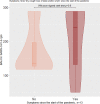Longitudinal change in SARS-CoV-2 seroprevalence in 3-to 16-year-old children: The Augsburg Plus study
- PMID: 35951611
- PMCID: PMC9371315
- DOI: 10.1371/journal.pone.0272874
Longitudinal change in SARS-CoV-2 seroprevalence in 3-to 16-year-old children: The Augsburg Plus study
Abstract
Background: Currently, more than 30,200,000 COVID-19 cases have been diagnosed in Germany alone. However, data regarding prevalence of COVID-19 in children, both in Germany and internationally, are sparse. We sought to evaluate the number of infected children by measuring IgG antibodies.
Methods: Oropharyngeal swabs were collected between December 2020 and August 2021 to measure SARS-CoV-2, and capillary blood for the detection of SARS-CoV-2 antibodies (by rapid test NADAL® and filter paper test Euroimmun® ELISA); venous blood was taken for validation (Roche® ECLIA and recomLine Blot) in 365 German children aged 3-16 years from 30 schools and preschools. We used multiple serological tests because the filter paper test Euroimmun® ELISA performs better in terms of sensitivity and specificity than the rapid test NADAL®. The Roche® ECLIA test is used to detect SARS-CoV-2 spike protein, and the recomLine Blot test is used to rule out the possibility of infection by seasonal SARS-viruses and to test for specific SARS-CoV-2 proteins (NP, RBD and S1). In addition, one parent each (n = 336), and 4-5 teachers/caregivers (n = 90) per institution were tested for IgG antibodies from capillary blood samples. The total study duration was 4 months per child, including the first follow-up after 2 months and the second after 4 months.
Results: Of 364 children tested at baseline, 3.6% (n = 13) were positive for SARS-CoV-2 IgG antibodies using Euroimmun® ELISA. Seven children reported previously testing positive for SARS-CoV-2; each of these was confirmed by the Roche® Anti-SARS-CoV-2-ECLIA (antibody to spike protein 1) test. SARS-CoV-2 IgG antibodies persisted over a 4-month period, but levels decreased significantly (p = 0.004) within this timeframe. The median IgG values were 192.0 BAU/ml [127.2; 288.2], 123.6 BAU/ml [76.6; 187.7] and 89.9 BAU/ml [57.4; 144.2] at baseline, 2 months and 4 months after baseline, respectively. During the study period, no child tested positive for SARS-CoV-2 by oropharyngeal swab. A total of 4.3% of all parents and 3.7% of teachers/caregivers tested positive for IgG antibodies by Euroimmun® ELISA at baseline.
Conclusion: We noted a rather low seroprevalence in children despite an under-reporting of SARS-CoV-2 infections. Measurement of IgG antibodies derived from capillary blood appears to be a valid tool to detect asymptomatic infections in children. However, no asymptomatic active infection was detected during the study period of 4 months in the whole cohort. Further data on SARS-CoV-2 infections in children are needed, especially in the group of <5-year-olds, as there is currently no licensed vaccine for this age group in Germany. The Robert Koch Institute's Standing Commission on Vaccination (STIKO) recommended COVID-19 vaccination for 12-17 and 5-11 year olds in August 2021 and May 2022 respectively.
Conflict of interest statement
The authors have declared that no competing interests exist
Figures






References
-
- Worldometers.info. Coronavirus Worldwide Graphs Dover, Delaware, U.S.A.2021 [cited 07/22/2022]. Available from: https://www.worldometers.info/coronavirus/worldwide-graphs/.
-
- Robert Koch-Institut (RKI): Covid-19 Dashboard [Internet]. Robert Koch-Institut (RKI), dl-de/by-2-0 2021. [cited 07/22/2022]. Available from: https://experience.arcgis.com/experience/478220a4c454480e823b17327b2bf1d4.
Publication types
MeSH terms
Substances
LinkOut - more resources
Full Text Sources
Medical
Research Materials
Miscellaneous

